3-D Film Archive, Proudly Presents "3-D RARITIES" |
Read more at in70mm.com The 70mm Newsletter |
| Press kit by: Bob Furmanek, 3-D Film Archive, LLC | Date: 22.07.2015 |
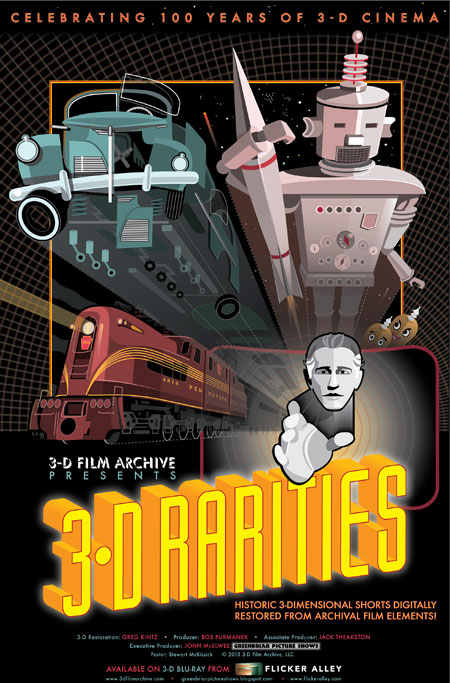 The first documented public exhibition of a 3-D motion picture took
place on June 10, 1915 at New York’s Astor Theatre. To commemorate the
centennial, the 3-D Film Archive is proud to present
"3-D RARITIES", an
amazing collection of stereoscopic treasures dating back to the dawn of
3-D cinematography. The first documented public exhibition of a 3-D motion picture took
place on June 10, 1915 at New York’s Astor Theatre. To commemorate the
centennial, the 3-D Film Archive is proud to present
"3-D RARITIES", an
amazing collection of stereoscopic treasures dating back to the dawn of
3-D cinematography.They include: Kelley's Plasticon Pictures: THRU’ THE TREES, WASHINGTON D.C., the earliest extant 3-D demonstration film from 1922 with incredible footage of Washington and New York City; NEW DIMENSIONS (aka MOTOR RHYTHM) the first domestic full color 3-D film originally shown at the New York World’s Fair in May 1940; THRILLS FOR YOU, a fascinating promotional film for the Pennsylvania Railroad, first shown in 1940 at the Golden Gate International Exposition in San Francisco; BOO MOON, an excellent example of color stereoscopic animation from 1953; DOOM TOWN, a controversial anti-atomic testing film which was mysteriously pulled from theatrical release after a few play-dates in July 1953; I’LL SELL MY SHIRT, a burlesque comedy unseen in 3-D for over 60 years; THE MAZE coming attraction trailer with fantastic 3-D production design by the legendary William Cameron Menzies, and much more. Presented in high quality digital 3-D, all films in 3-D RARITIES have been restored and mastered in 2K from original 35mm elements for optimum quality. Meticulously re-aligned shot by shot for precise registration of the original left/right elements, these historic 3-D films have never before looked this good! 1. Opening Titles – .55 2. Kelley’s Plasticon Pictures – 7.41 3. John Norling/Jacob Leventhal tests – 5.13 4. Thrills for You – 8.26 5. New Dimensions – 9.08 6. M.L. Gunzburg Presents Natural Vision 3-Dimension – 5.23 7. It Came from Outer Space trailer – 3.39 8. Hannah Lee trailer – 2.07 9. Stardust in Your Eyes – 6.10 10. The Maze trailer – 2.16 11. Doom Town – 15.25 12. The Adventures of Sam Space – 9.13 13. I’ll Sell My Shirt – 7.22 14. Miss Sadie Thompson trailer – 3.00 15. Boo Moon – 7.33 16. End Credits – 1.00 Running Time – 94 minutes CREDITS 3-D Restoration – Greg Kintz. Producer – Bob Furmanek. Associate Producer – Jack Theakston. Executive Producer – John McElwee, Greenbriar Picture Shows. New Stereoscopic Restorations 2015 3-D Film Archive, LLC. For more information, please visit www.3dfilmarchive.com |
More in 70mm reading: 3D festival September 2003, Los Angeles, USA 3D IMAX 70mm today Director Shows 70mm 3-D At LFCA PDF: 3D Rarities DCP Master Press 3-D Rarities Press Release BluRay Internet link: 3-D Film Archive Imdb |
"3-D RARITIES" |
|
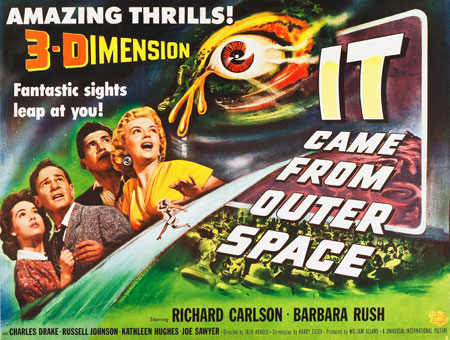 Kelley’s Plasticon Pictures (1922 – 1923) Kelley’s Plasticon Pictures (1922 – 1923)Jack Theakston Anticipating the release of Laurens Hammond's "Teleview" show at the Selwyn Theatre, William van Doren Kelley (Prizma, Inc., color films) booked the first widely-seen 3-D film, Movies of the Future at the Rivoli Theatre in New York City during the Christmas 1922 run of Back Home and Broke with Thomas Meighan. Released on December 23 under the "Music Films, Inc." banner—a company that produced color shorts utilizing an on-screen baton to maintain sync with the orchestra (invented by 3-D pioneer Jacob Leventhal and seen in one shot in this film)—Kelley's Plasticon short was featured alongside Music Films' Toddling Tots with the Hastings Twins. Having previously presented the first showing of a stereoscopic film in the U.S., William E. Waddell, who had produced the 3-D tests with Edwin S. Porter in 1915, was also a partner in Music Films, Inc. Newspaper praise for Movies of the Future was quite good. "Persons accustomed to viewing ordinary flat pictures cannot easily anticipate the effect of seeing every object in the scene stand out with length, breadth and thickness as it does in life" wrote The New York Times. "They do just this, in Mr. Kelley's short film, which is composed of scenes in and about New York City." The popular program moved to the Rialto Theatre for a second week. This demonstration reel, including the follow-up film Thru’ the Trees – Washington, D.C. (this time specifically shot by William T. Crespinel - Kelley's business partner at Prizma) was prepared for a June 27, 1923 technical meeting in Swampscott, MA, followed by a meeting in Ottawa, Canada of the Society of Motion Picture Engineers from October 1-4, 1923. It is likely, but unconfirmed, that the opening portion and closing portion of this surviving short is Movies of the Future in totem or perhaps a truncated version of the short shown at the Rivoli. |
|
 John Norling/Jacob Leventhal tests (1935) John Norling/Jacob Leventhal tests (1935)Jack Theakston Forming Visual Pictures, Inc. to continue Leventhal's 3-D experiments, Leventhal and John Norling shot these tests sometime in early 1935. Most of the gags are re-enactments of the most popular effects in the earlier Stereoscopiks shorts. Locations include Riverside Drive turning onto the newly-completed George Washington Bridge (re-enacting effects seen in A Runaway Taxi), the Thunderbolt rollercoaster on Coney Island (similar to the effects seen in Luna-cy) and a baseball game in Dexter Park, Queens, N.Y., home of the Bushwick Baseball Club and the Negro Baseball League team, the Brooklyn Royal Giants. Look closely, as in one shot in the film, a black batter can be seen playing on an integrated team at least ten years before "Jackie" Robinson would play for the Brooklyn Dodgers and break segregation in the Major Leagues. The well-rehearsed tests were enough to sell MGM short subject producer Pete Smith on the idea, and the studio released Audioscopiks on January 11, 1936. It was nominated for the best Novelty Short Subject at the 8th Academy Awards in March 1936. Thrills For You (May 25, 1940) Hillary Hess One year after visitors to the 1939 New York World’s Fair were introduced to polarized 3-D projection with Chrysler’s promotional short, In Tune With Tomorrow, the Pennsylvania Railroad gave Polaroid 3-D its west coast premiere with this film at the Golden Gate International Exposition in San Francisco. Produced by the same team as the Chrysler film, but rather than featuring whimsical stop-motion animation, this one takes a documentary approach with careful composition in depth and dynamic point-of-view angles to impart the sensation of traveling on “the world’s most modern railroad.” Only the new polarized “magic movies” could be sufficiently modern to provide no less than five proud shots of the iconic streamlined, Raymond Loewy designed GG1 electric locomotive. Equally stunning in depth are the muscular K4 engines under full steam. The scope of the railroad’s impressive capacity is illustrated by scenes of its freight service and maintenance facility at the legendary Altoona Pennsylvania shops. The sales pitch is at full throttle when we ride along with the Pennsy’s passengers in every type of offered luxury. And while the accommodations appear spacious enough for inside a train, one marvels at how the Norling dual-camera 35mm 3-D rig could fit inside compartments which could not possibly be as large as the camera seems to portray. Added depth is provided by the genuine landscape passing by outside the windows. No rear-projection here! Ephemeral by design, the PRR gifted us today with an opportunity to experience the era of elegant rail travel, preserved in time and space. It is a visceral look back into the long-defunct railroad as it was looking ahead. Just watch out for that oncoming train! New Dimensions (May 11, 1940) Jack Theakston With In Tune with Tomorrow averaging over 250,000 viewers a month during the 1939-40 New York World’s Fair, Chrysler once again enlisted Loucks & Norling to top itself with yet another stereo promotional film. Expanding upon the brief animations shown in the first short, New Dimensions would be all about the Plymouth and how it was made. Shot stop-motion, full-scale and in color, John Norling had a significantly expanded budget to work with, but added challenges to the production. “Our problem in producing New Dimensions was to simulate the manufacture of a Plymouth Sedan by having each part travel to its proper place in the car without visible support,” he wrote in Business Screen Magazine. Using an overhead crane built especially for the short, the solution to hiding the wires was an old animation trick: paint the piano wires holding the parts up the corresponding background color just before each take. Using Norling’s own camera rig, red, green and blue sequential animation separations were taken through color filters mounted on the front of each lens. A rousing score that follows the picture was the work of veteran composer George Steiner. Norling explained the timings: “Each movement was planned in advance. First, the music was written and recorded; every beat and most notes were marked off on the music track and measured exactly to the frame to provide the master synchronizing data…We followed this music score religiously in order to assure the maintenance of exact synchronism throughout the picture.” For an 890-foot short, the picture took nine weeks to photograph, with Norling and his crew eking out nine feet of film a day at best. Opening for the May 1940 season of the fair, New Dimensions was even more popular than its predecessor. Chrysler’s 339-seat theater was often filled to capacity, filling the peripheral vision of spectators with its 60x40-foot screen. By October 1940, an estimated 4.5 million people had seen the exhibit. So popular was the film that it enjoyed a brief tour throughout the country after its run at the World’s Fair. In 1953, RKO Pictures picked it up for theatrical distribution, retitling it Motor Rhythm. We have restored the short from the only surviving 35mm Technicolor print which is deteriorating and shrunken with vinegar syndrome. The bookends that were cut for its re-issue came from the only known 16mm print. |
|
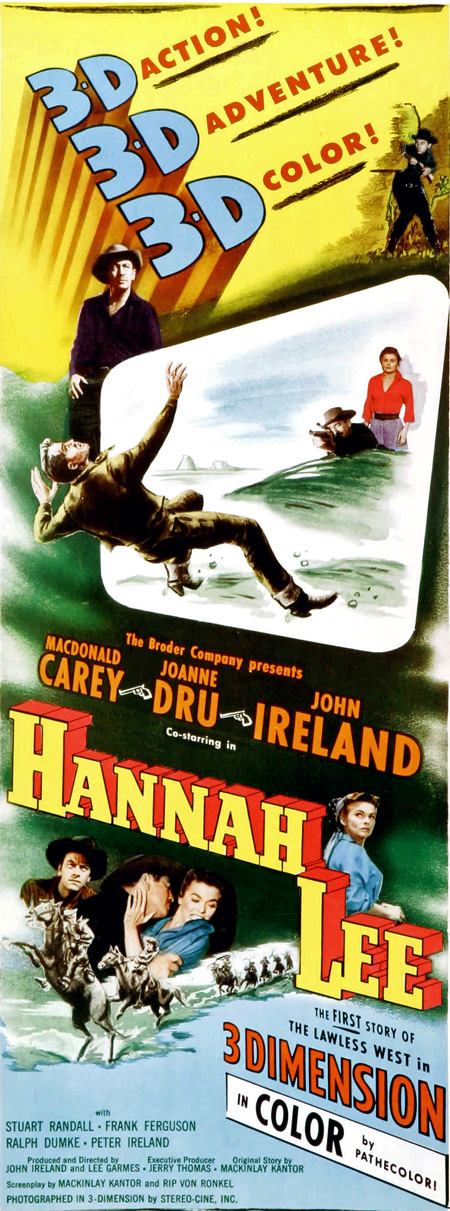 M.L. Gunzburg Presents Natural Vision 3-Dimension (November 26, 1952) M.L. Gunzburg Presents Natural Vision 3-Dimension (November 26, 1952)
Ted Okuda Milton Lowell Gunzburg, president of Natural Vision Corporation, supervised prominent 3-D productions, including Bwana Devil, House of Wax and The Charge at Feather River. Made as a prologue to Arch Oboler’s Bwana Devil, this short explains how Natural Vision 3-D works and is “healthy and beneficial” for your eyes. Lloyd Nolan (A Tree Grows in Brooklyn) serves as our guide, introducing us to Beany and Cecil (voiced by Daws Butler and Stan Freberg, respectively), stars of Bob Clampett’s Time for Beany television show, and Miss U.S.A of 1949 Shirley Tegge, newly-christened “Miss Third Dimension.” According to Natural Vision cameraman Lothrop Worth, this footage was shot in the library of the Berch Estate, a Beverly Hills mansion. In October 1952, Gunzburg announced a deal with Bob Clampett and Frank Tashlin to make a feature-length Beany and Cecil movie in 3-D, though the project never materialized. The iconic Life magazine photo of elegantly-dressed moviegoers wearing 3-D glasses depicts the audience watching this film at the world premiere of Bwana Devil in Los Angeles on November 27, 1952. Five months later, this short became the first 3-D film ever shown on television (April 29, 1953) during a test broadcast on KECA in Los Angeles. Among other 3-D features photographed with the Natural Vision rig: Fort Ti, Devil's Canyon, The Moonlighter, Top Banana, Southwest Passage, Gog and September Storm. The camera was used for the last time on the nudie-cutie Adam and Six Eves which was released only flat in August 1962. It Came from Outer Space trailer (May 23, 1953) Ted Okuda It Came from Outer Space, Universal-International’s first science-fiction movie, remains one of the most highly-regarded of all 3-D films. Directed by Jack Arnold (Creature from the Black Lagoon, The Incredible Shrinking Man) and based on a story by Ray Bradbury (The Martian Chronicles, Fahrenheit 451, The Beast from 20,000 Fathoms, The Illustrated Man), this seminal aliens-are-among-us thriller ranks alongside the finest sf films ever made. Although photographed for the standard ratio of 1.37:1, It Came from Outer Space was the first 3-D feature to be shown in major cities in widescreen at 1.85:1, and was only the second feature released in three-channel stereophonic sound. (The first was Fort Ti.) This was also the first trailer actually made in 3-D to promote a 3-D feature, and includes the super-rare tag for the first musical featurette in 3-D, Nat "King" Cole and Russ Morgan and his Orchestra, the short that accompanied It Came from Outer Space. (Universal offered exhibitors “the First All 3-D Program.”) Hannah Lee trailer (June 19, 1953) Julian Antos There is a certain poetry inherent in a trailer for a total flop of a film. “We have a very fine picture,” says John Ireland in the trailer for Hannah Lee, the 1953 Western he starred in, directed, and co-produced, and his sense of discomfort is so transparent that you might just want to believe him out of sympathy. Ireland wasn’t lying: Hannah Lee is indeed a fine picture, but one saddled with financial and technical problems and public controversy. Independently produced by Jack Broder, it opened to reviews that accused the film of being incomprehensible, with 3-D effects that were “Well below what has been seen in other 3-D films thus far” according to Exhibitor magazine. Following the mediocre reception, Ireland and his wife and co-star Joanne Dru sued Broder for $500,000, claiming they were owed 10% of the film’s profit on a verbal agreement. Broder quickly countersued for $200,000, accusing Ireland of going $175,000 and 7 days over schedule, and hiring a writer to revise the screenplay and, from the Los Angeles Times, “insert his own ‘erratic’ ideas into the photoplay.” The trouble didn’t end there. Three years later Broder was sued by Pathe Laboratories for $109,291 in unpaid bills. Broder countersued for $1,000,000, accusing Pathe of botching the lab work and ruining the films potential. The Court ruled that Broder was to pay $50,000 and receive a $50,000 credit from the lab. Whether or not Broder ever used it is unclear: he didn’t produce another film until 1966. Note: 18 seconds of footage promoting the 3-D release was removed from the right eye negative for a flat reissue. That footage is lost and presented flat in this restoration. |
|
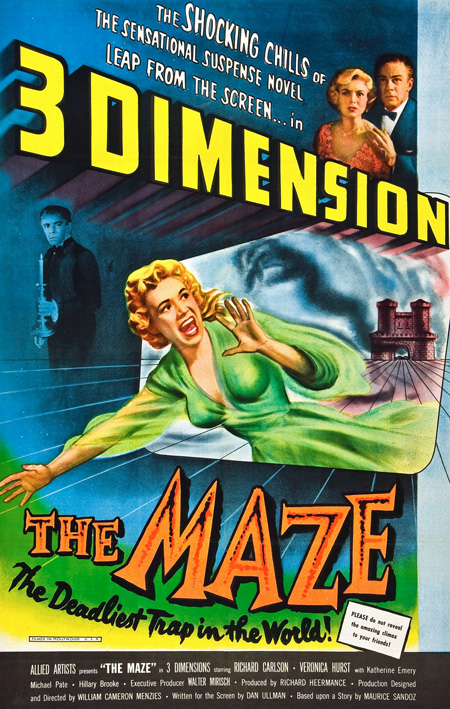 Stardust in Your Eyes (June 24, 1953) Stardust in Your Eyes (June 24, 1953) Ted Okuda Shot by producer-director Phil Tucker in May 1953 as an opening for his 3-D cult favorite Robot Monster, Stardust in Your Eyes showcases “My Heart is Owned and Operated By You,” a song composed by nightclub comic Slick Slavin—misspelled “Slaven” in the credits—who is actually Trustin Howard, a respected comedy writer (The Joey Bishop Show), actor (Career, King Creole, The Bride and the Beast), composer (he wrote the classic rockabilly title song for 1958’s Speed Crazy and also sang it in the film) and author (Winchell and Runyon: The True Untold Story)—and highlights his impressions of Cary Grant, Jimmy Stewart, Ronald Colman, James Cagney, Humphrey Bogart, Larry Parks as Al Jolson (a great in-joke for movie buffs), Peter Lorre, Sydney Greenstreet and Charles Laughton. This delightful standup routine has proven to be a big hit at 3-D festivals. Tucker caught Slavin’s nightclub act while vacationing in Alaska. Duly impressed, Tucker gave him his business card; when Slavin showed up at the Hollywood casting call for this short, Tucker immediately hired him. Stardust in Your Eyes was filmed in a single take in front of an outdoor backdrop. A seasoned pro, Slavin effortlessly ad-libs when the sound of a plane flying overhead threatens to disrupt his performance. Lost until 1985 when it was found by the 3-D Film Archive in a Hollywood movie lab and rescued in the nick of time (the negatives were slated to be junked), Stardust in Your Eyes captures the talented Mr. Howard at his hilarious best. The Maze trailer (June 30, 1953) Ted Okuda Directed by William Cameron Menzies (Invaders from Mars, Things to Come), who also served as production designer, The Maze is a wild mixture of mystery, horror and science-fiction elements, all wrapped up in glorious 3-D. A modestly budgeted effort from Allied Artists (formerly Monogram Pictures), the film benefits tremendously from Menzies’ technical expertise, as he uses shadow, lighting and inventive set designs to evoke a chilling, atmospheric mood. Menzies filmed the 3-D trailer footage with lead star Richard Carlson (It Came from Outer Space, Creature from the Black Lagoon) on April 29, 1953. Menzies also filmed two 3-D shorts in late February 1953: Acrobaticks and Fun in the Sun. They were to be part of producer Sol Lesser's never-completed feature The 3-D Follies, and are now lost. What is the terrible secret of the Scottish castle in The Maze? We’re certainly not going to spill the beans (or whatever it is they spill in Scotland) but this trailer, stunningly restored to 3-D, will entice you to find out. |
|
 Doom Town (July 2, 1953) Doom Town (July 2, 1953)
Ted Okuda The first 3-D documentary, Doom Town was made by independent producer Lee Savin, who was intrigued by the atomic-bomb tests at Yucca Flats in Nevada. Filming began March 17, 1953. Photographed with the Dunning Three-Dimensional Process, it captured the devastating effects of an atomic blast. Doom Town was written by screenwriter-director-author Gerald Schnitzer, whose credits included scripts for Bela Lugosi (The Corpse Vanishes, Bowery at Midnight) and The Bowery Boys. Schnitzer also created several acclaimed TV commercials for Kodak (“Kodak Moment”), Chevrolet, and Clairol. Doom Town was sneak-previewed on April 30 at the Paramount Theater in Hollywood and opened in Los Angeles on July 2 with The Maze and Lippert’s 3-D short, College Capers. The next day it opened at the Telenews theaters in San Francisco and Oakland. After these bookings, it was mysteriously pulled from circulation. Although the project was approved by proper channels, the anti-atomic testing stance was hardly a message the government wanted to promote. Was Doom Town suppressed? Nobody seems to know but the movie disappeared without a trace in July 1953. It was lost for decades until the negatives, slated to be junked, were discovered and salvaged by the 3-D Film Archive in 1985. The separate reel with the color atomic bomb shots was missing; a recreation was done in 2003 by Peter Kuran, using actual 3-D atomic bomb footage. The original "multi-sound" has been recreated by Greg Kintz. Years ahead of its time, Doom Town is a prescient social statement and an excellent example of 3-D filmmaking. The Adventures of Sam Space (September 1960) Ted Okuda “Takes YOU on a Thrilling Flight through Time and Space!” In trade-journal announcements (July 3, 1953), Robert Angus and James Banks, of Volcano Productions, envisioned The Adventures of Sam Space as the first in a series of theatrical 3-D puppet cartoons, utilizing the animation seen in George Pal’s Puppetoons. In fact, writer-director Paul G. Sprunck had worked on the Puppetoons and similar shorts. He also designed the character of Sam Sawyer in 1950 for Sawyer’s Inc. Production began on July 22, 1953 at General Service Studios with “Photography and Special Effects” by the Howard A. Anderson Company, utilizing a stereoscopic camera system. Arthur C. Pierce, then a cameraman with the Anderson firm, received “Screen Adaptation and Production Supervisor” credit. Character voices were supplied by the legendary Paul Frees (Boris Badenov, Ludwig Von Drake, Pillsbury Doughboy), with animation by Herb Price and music score by Clarence Wheeler (Puppetoons). Filming wrapped the week of October 17. After completion, it went unreleased, a victim of the dying 3-D market. In September 1960, Banks sold it to producer Edward L. Alperson. Re-titled Space Attack, it was released as a “Special Added Attraction” with Alperson’s September Storm, the last dual-35mm 3-D feature. Photographed open-matte at an aspect ratio of 1.37:1, Space Attack was horribly cropped to 2.35:1. Original elements no longer exist. 3-D collector David Janzow purchased the sole surviving 35mm left/right print in the late 1960s. The 3-D Film Archive acquired the badly-faded print and the result is this stunning restoration, presented for the first time in its intended ratio of 1.75:1. |
|
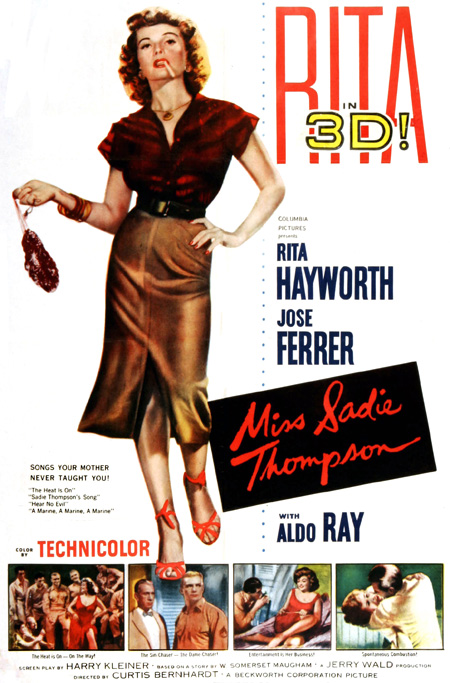 I’ll Sell My Shirt (October 1953) I’ll Sell My Shirt (October 1953)
Ted Okuda “Side-splitting Comedians and Beautiful Girls in 3-D” Low comedy meets high technology in I’ll Sell My Shirt, a burlesque film unseen anywhere in 3-D for over 60 years. Corky Marshall, known as “The Clown Princess of Comedy” and “Da Brooklyn Lovebird,” receives top billing but the real mirthmakers are George “Beetlepuss” Lewis and Charlie Crafts, cited as “One of Burlesque’s Greatest Comedy Teams” by Billboard magazine. I’ll Sell My Shirt was produced by exploitation-movie distributor Dan Sonney (Striptease Girl), who jumped on the 3-D bandwagon in May 1953 when he added a twelve-minute 3-D sequence to A Virgin in Hollywood (1952) and released the “new” picture as Side Streets of Hollywood. Sonney and producer Willis Kent (Wages of Sin) then made five 3-D shorts in July 1953 at the Follies Theatre in Los Angeles but they went into release just as interest in 3-D properties began to wane. Cinematographer William C. Thompson, no stranger to burlesque movies (French Follies, Striptease College), was director of photography on the grindhouse epic Maniac (1934) as well as Ed Wood’s cult classics (Plan 9 from Outer Space, Bride of the Monster, Glen or Glenda). This restoration of I’ll Sell My Shirt was taken from the original 35mm left/right elements and displays Thompson's deep stereoscopic widescreen cinematography better than ever before. (It was only shown in red/green anaglyphic 3-D in its original release.) The short was rescued just in time. The elements are shrunken and rapidly deteriorating with vinegar syndrome. I’ll Sell My Shirt is not only one of the rarest burlesque movies; it is one of the rarest of all 3-D films. And one of the funniest too. Miss Sadie Thompson trailer (December 23, 1953) Ted Okuda Columbia Pictures adapted W. Somerset Maugham’s story Rain as a vehicle to showcase Rita Hayworth, one of the studio’s biggest stars, and the 3-D process (“Rita Sings in 3-D...Rita Loves in 3-D”). Directed by Curtis Bernhardt (A Stolen Life, Possessed, Interrupted Melody), this tale of a free-spirited South Seas trollop (Hayworth) who clashes with a fiery preacher (Jose Ferrer) was only the second feature ever to be recorded on location in multi-track sound. (The first was This is Cinerama, a non-3-D production.) Filming began with exteriors shot on the island of Kauai, Hawaii on March 31, 1953. Miss Sadie Thompson was originally released in three-channel stereophonic sound. Unfortunately, those tracks have not survived. Composed for 1.85:1, the pictorial image of this trailer was slightly zoomed-in, so it is being presented here in 1.66:1. Boo Moon (December 25, 1953) Thad Komorowski Animation and 3-D seem like two peas in a pod if you look at today’s modern box office lineup, or at how successfully Famous Studios (the independent entity under Paramount’s control) did it with Boo Moon. But in 1953, making a cartoon in 3-D meant shaking up a well-oiled machine. In the postwar years, Famous cartoons generally didn’t see release until two years after they were started. When 3-D did roll around, it was decided very late in production that both the Casper cartoon and Popeye, the Ace of Space could transform quite successfully into widescreen, three-dimensional sci-fi epics. Paramount wanted the cartoons to knock socks off, so no expense was spared and production was expedited. On average, an early ‘50s Famous Studios cartoon cost around $32,500. Famous received extra money for the 1953-54 season that allowed the budget for the two 3-D cartoons to climb north of $70,000 apiece. As you’ll see from this fantastic restoration of Boo Moon, the grandiose lunar settings and epic special effects show that the money did indeed reach the screen. Famous specialized in a children audience, and there’s no doubt the cartoon, released at the height of Casper’s popularity, passes their approval. But the depth and extent of the 3-D in Boo Moon ensures that an audience of any age will find it as fun and satisfying as anything ever done in the process. |
|
Flicker Alley Presents "3-D Rarities" On Bluray |
|
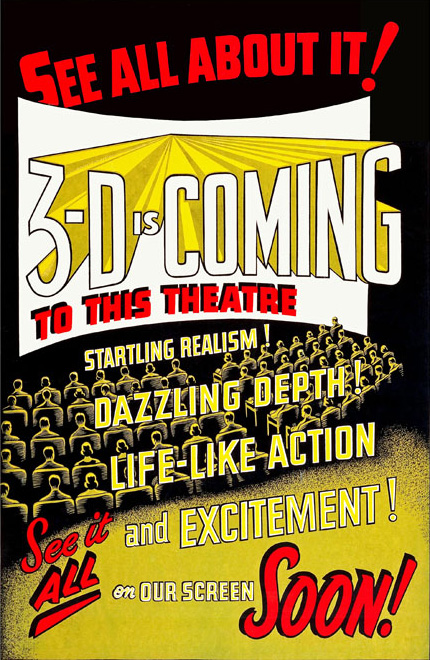 Flicker Alley, in partnership with the 3-D
Film Archive, releases 3-D Rarities, a collection of 22 ultrarare and
stunningly restored 3-D films in a Blu-ray premiere. Flicker Alley, in partnership with the 3-D
Film Archive, releases 3-D Rarities, a collection of 22 ultrarare and
stunningly restored 3-D films in a Blu-ray premiere.Release Date: June 16, 2015 (Los Angeles, CA - March 31, 2015) – In commemoration of the centennial of 3-D motion pictures, Flicker Alley and the 3-D Film Archive are proud to present for the first time on Blu-ray – or any home-video platform – this newly restored and carefully curated collection of 3-D Rarities. "3-D Rarities". Deluxe Blu-ray Edition. M.S.R.P. $39.95. 3-D Rarities / 1922-1962 / 147 minutes / USA / Produced by Bob Furmanek and the 3-D Film Archive. UPC: 6-17311-67919-3 ISBN: 1-893967-91-3 It has taken over 30 years for the 3-D Film Archive to assemble and restore the material in 3-D Rarities, an eye-popping collection of ultra-rare and long-lost movies, which Flicker Alley and the 3-D Film Archive are proud to present here for the first time on Blu-ray. Selections include Kelley's Plasticon Pictures, the earliest extant 3-D demonstration film from 1922 with incredible footage of Washington and New York City; New Dimensions, the first domestic full color 3-D film originally shown at the World’s Fair in 1940; Thrills for You, a promotional film for the Pennsylvania Railroad; Around is Around, a 3-D animated gem by Norman McLaren; Rocky Marciano vs. Jersey Joe Walcott, the only 3-D newsreel; Stardust in Your Eyes, a hilarious standup routine by Slick Slavin; trailer for The Maze, with fantastic production design by William Cameron Menzies; Doom Town, a controversial anti-atomic testing film mysteriously pulled from release; puppet cartoon The Adventures of Sam Space, presented in widescreen; I’ll Sell My Shirt, a burlesque comedy unseen in 3-D for over 60 years; Boo Moon, an excellent example of color stereoscopic animation…and more! Presented in high-quality digital 3-D, all films have been stunningly restored and mastered direct from archival materials by 3-D Film Archive Technical Director Greg Kintz. Meticulously aligned shot by shot for precise registration of the original left/right elements, these historic 3-D motion pictures have never looked this good. Bonus Materials Include: • Introductions by Leonard Maltin and Trustin Howard. • Essays by Julian Antos, Hillary Hess, Thad Komorowski, Donald McWilliams, Ted Okuda, Mary Ann Sell and Jack Theakston. • 3-D photo galleries - Hunchback of Notre Dame (1923), New York World's Fair (1939), Sam Sawyer View-Master reels (1950) and 3-D Comic Books (1953) • 3-D footage directed by Francis Ford Coppola from The Bellboy and the Playgirls (1962) • Commentary tracks by Thad Komorowski and Jack Theakston. To Watch the 3-D Versions of These Films, You Need: • 3D HDTV • Compatible 3D Glasses • Blu-ray 3D™ Player or Playstation®3 System • High-Speed HDMI Cable This Blu-ray Can Also Be Viewed in 2D, Playable on Your Standard Blu-ray Player. About the 3-D Film Archive The 3-D Film Archive is an organization dedicated to preserving and restoring historic stereoscopic films. Founded in 1990 by Bob Furmanek, the 3-D Film Archive controls the distribution of more than two dozen 3-D films made from 1922 to 1970. More information on the 3-D Blu-ray can be found here: 3dfilmarchive.com. About Flicker Alley, LLC Flicker Alley, LLC was founded in 2002 by Jeff Masino. Each Flicker Alley publication is the culmination of hundreds of hours of research, digital restoration, graphic design, music composition and scoring. Collectively, they reflect the creativity, expertise, and shared passion of many talented collaborators. The Flicker Alley brand has grown to enjoy national and international critical acclaim. The company is a four-time recipient of the National Society of Film Critics Film Heritage Award for publishing "rare early U.S. and foreign silent film." Contact Flicker Alley, LLC (323) 851-1905, info@flickeralley.com |
|
| Go: back - top - back issues - news index Updated 22-01-25 |
